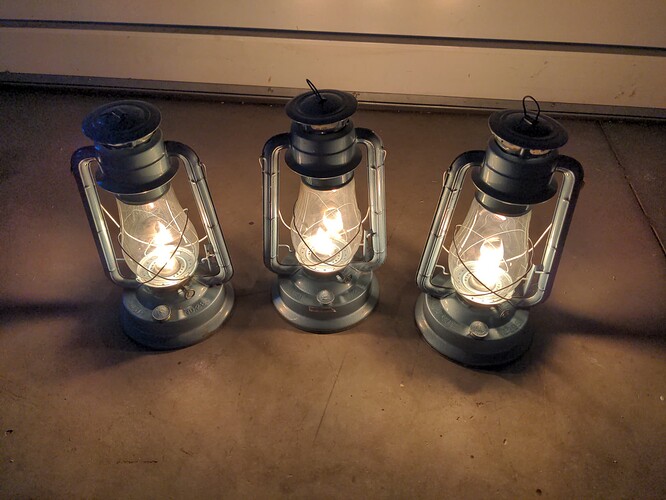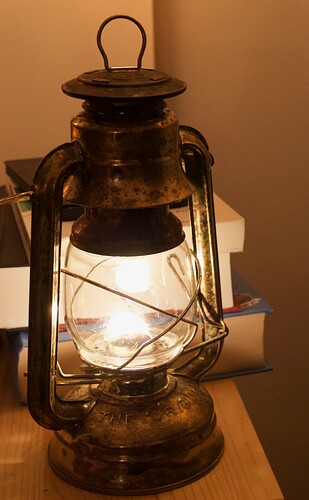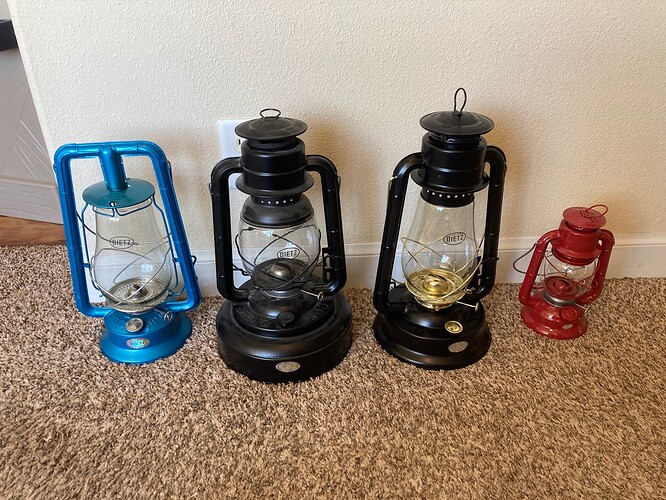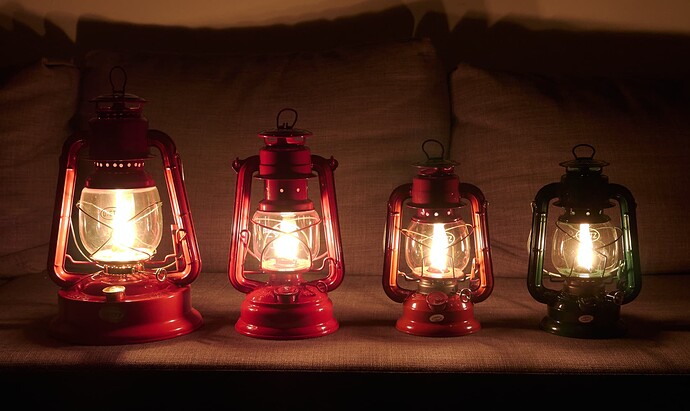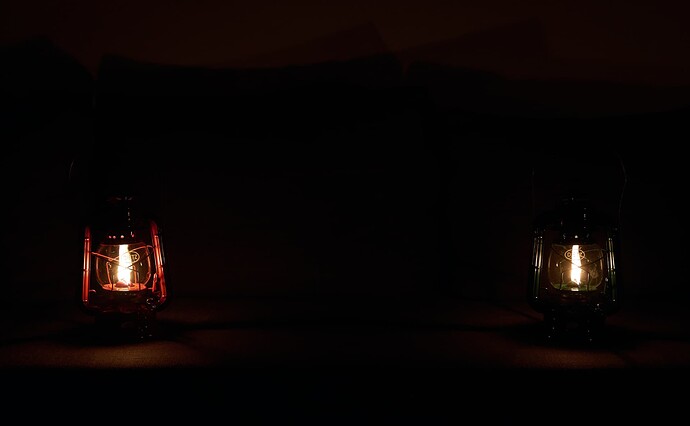I, too, have received some comets recently: a brace of them, in red and green. I decided to take a family portrait. The lighting is not controlled in this shot and there’s a white-balance different from left to right due to an open window, so the colours aren’t reproduced exactly right (the Little Wizard is closer in colour to the comet than the Feuerhand):
Those are, left to right in the image:
- A Dietz Little Wizard (large font, there is apparently a small-font option for that lantern)
- A Dietz #76 “Original”
- A Feuerhand “Baby”
- Two Dietz Comets
Pursuant to Science™, I decided to compare a local “lamp oil, paraffin-based” with Klean Heat “kerosene alternative” to see if they behaved differently in lanterns. I discussed with the vendor and was told that the lamp oil was a commercial product known as “ISOPAR M”, from ExxonMobil, and that it was “only slightly more viscous than kerosene”. Reading online about such substances (another commonly referred to product is Recochem’s “Lamp Oil - Paraffin-based” which is also ISOPAR M) there is mixed opinion, with some lantern sites saying it is suitable for lanterns and others saying it is only suitable for small round-wick lamps and “oil candles”. So I decided to see for myself how it behaves in a proper cold-blast lantern, and since I had two comets it was a perfect chance to do some side-by-side comparisons.
So I filled up the lanterns to let the wicks soak for a while. The red comet got Klean Heat, the green one ISOPAR M. I filled them in the afternoon and came back in the evening several hours later to light them off.
The comets are painted, even around the flame area of the burner, so I can’t report on the smell of the fuel burning yet, because all I could smell was burnt plastic paint during this first firing. After that’s burnt off and the lanterns burn cleanly, I’ll try to follow up with a report on any noticeable differences between the fuels from an operational standpoint. But I was able to get some good photos to show you the difference in light output.
Here are some photos of the results. First up, a family photo, lit (minus the #76, which was pulling duty elsewhere):
Already we can see that the green comet is putting out a bit less light, but it’s not a huge difference. I was wondering if some of that was due to the colour difference in the lanterns (red reflecting more, perhaps), so I took a very stopped down shot, first of the family of lanterns, then of the two comets:
It should be clear from these photos that the ISOPAR M is about “half” as bright as the Klean Heat, which I confirmed by spot metering the two flames as well. The shape is different, with the more viscous (e.g. heavier hydrocarbon chains) ISOPAR M showing a more streamlined, narrow flame than the Klean Heat, which spreads more readily and offers both more surface area of flame and a brighter flame.
In all these photos the wicks were adjusted (on all lanterns, for comparison) to the same exposed-wick height, as best as I could eyeball it.
OK, you might say, the ISOPAR M burns less brightly, and with a smaller flame. How big of a deal is this?
Well, here are some comparison shots to give you perhaps a situational feel:
While the photos aren’t the same as being in the room with the lanterns, the difference is approximately well conveyed. I would sum it up as: Klean Heat is definitely, noticeably brighter, but if all you can get is ISOPAR M in one of its various consumer-packaged brandings, it will still be a useful amount of light. I wouldn’t want to use it in the bigger lanterns, partly because the increased viscosity might starve the wick if it has farther to draw and you have the lantern turned up fully, and partly because the lower light output will be more meaningful of a difference with a bigger, brighter lantern, but in a pinch? Sure, it should work fine. My guess is that it’ll flow well enough, once the lantern and the fuel warm up a bit, to be just fine even in the bigger lanterns if you can live with the reduced light.
On the other hand, it’s perfectly suitable for a utility lantern or a decoration. The light of the comets, either of them with either fuel, is perfectly bright enough to get around the house, cook, eat, or wash up by if necessary, and even bright enough to read a book if the lantern is pretty close to you and in an advantageous position to illuminate the pages clearly. The other lanterns are even brighter, and the Little Wizard, if I really turn it up to max, is “quite bright” for room illumination purposes. I’m not sure how useful any of them would be when trying to navigate a path through the woods under cover of darkness, but if I get a chance to explore that, I’ll do my best to report the results.
In summary: if you can get Klean Heat I’d say it’s definitely worth it over the ISOPAR M for illumination purposes, unless the price is just ridiculous in which case I’d say get 1-K unless you’ll be burning these indoors extensively, in which case the ISOPAR M might be adequate, and will certainly smell better than 1-K.
I’ll leave you with a last photo, for fun.





